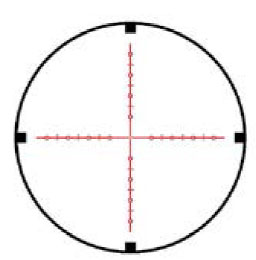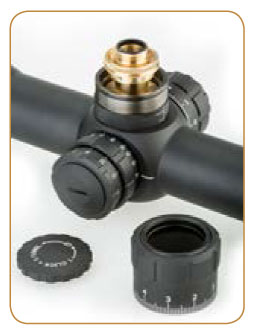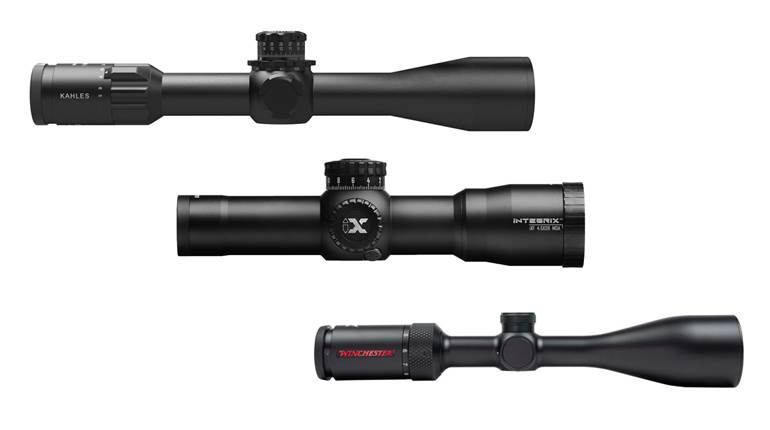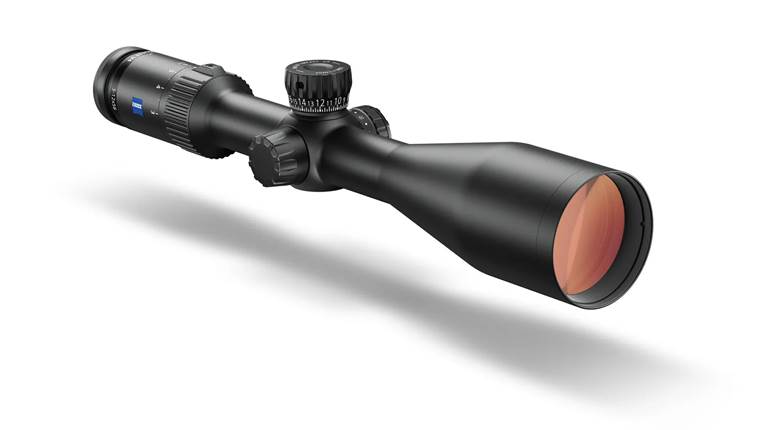
Primarily known for its hunting scopes, Weaver Optics recently entered the increasingly sizable realm of high-performance, “tactical” riflescopes. As evidenced by the Japanese-made 6-30X 56 mm Tactical model reviewed here, Weaver didn’t do so ill-prepared or half-heartedly; the company obviously noted shooters’ needs and market trends.
For dedicated long-distance shooters, specific design elements are desirable, if not mandatory; take a first-focal-plane reticle, for example. In a riflescope with a second-focal-plane reticle, the size of the reticle in relation to the target—or subtension—continually changes with adjustments in the magnification setting, and requires a single setting be maintained to accurately use range-estimation and holdover markings within the reticle.
By contrast, in first-focal-plane riflescopes, such as the Weaver Tactical 6-30X 56 mm, the reticle increases or decreases in size in relation to the target, thus allowing subtension to remain constant. This permits accurate range-estimation and holdover values across the entire range of magnification settings.

The Tactical 6-30X 56 mm’s Improved Mil-Dot Ranging (IMDR) reticle is configured for long-range targeting, too. The etched-glass design features four evenly separated circles on each of the four sides of the crosshair’s center. A hash at the 0.5-mil. mark bisects each pair of circles. Center-to center, the circles measure 1 mil. Moreover, the circles’ open center is 0.1-mil. wide, and the outer circle diameter is 0.2 mil. The hash marks, on the other hand, are 0.05-mil. thick and measure 0.25 mil. in length. Lastly, from each thick portion of the crosshair to that opposite of it—both horizontally and vertically—measures 10 mils., and the center of the crosshair is open for easier target acquisition.
To improve sighting in low-lght conditions, the scope provides reticle illumination by way of a 3-volt CR2032 battery located beneath the low-profile, slotted battery cap of the illumination turret, which itself is an extension of the parallax-adjustment knob. The user can select between green and red lighting and five intensities each. Two “0” positions represent “off.” Although the directions accompanying the optic state, “To change the battery, simply insert a tool or coin into the battery cap slot and turn counterclockwise,” that was easier said than done; a coin wouldn’t budge the cap, and only after using a proper-size screwdriver and significant force would the cap finally dislodge. During said process the cap was marred. Replacing and removing the battery cap several times afterward proved to be easy. To maintain its waterproof seal, the battery cap must be snugged tightly.

Weaver’s approach to the allimportant “zero stop” is coined “SmartZero,” and it permits the user to make rapid, accurate elevation adjustments and return to absolute zero without viewing the turret or counting clicks. To utilize, first withdraw the turret cap screw, remove the turret dial from the turret body and then loosen (but do not remove) the two setscrews using the provided small hex wrench. Next, using the included large hex wrench, rotate the center hex bolt clockwise until it bottoms out, at which point the two small setscrews can be retightened. The user now has access to the full range of available elevation travel. The turret dial is then temporarily reinstalled for zeroing. After zeroing, the turret dial is removed, the two setscrews are loosened, the outer base ring is pushed down and rotated clockwise until it stops, and the setscrews are retightened. The SmartZero is now set. Lastly, with the turret dial’s “0” aligning with the line on the turret body, the dial is reinstalled and the cap tightened above it. Seemingly complicated, the process is straightforward and easily accomplished, and it results in an absolute zero stop. As for click value, that of the Tactical 6-30X 56 mm evaluated was 1/10 mil., which changes the point of impact by about 0.36" at 100 yds. or 10 mm at 100 meters. The clicks are consistent, positive and secure. The scope has 80-m.o.a. worth of elevation adjustment, and there’s a 40-m.o.a. range of adjustment for windage.
Parallax adjustment is accomplished via the wheel/knob located on the left side of the scope. Graduated from 35 yds. to “infinity,” it has sufficient tension so as to not be inadvertently moved. And, as with the turret dial, rheostat and magnification band numerals, those on the parallax-adjustment knob are sized large enough to see when positioned behind the scope. The grooved magnification band features an elevated tab to aid purchase during adjustment. As with the other dials and turrets, movement of the magnification band requires a concerted effort, which is ideal.
Lastly, as with most sporting optics today, and especially on top tier models, the Tactical’s precision ground and polished lenses are fully multi-coated and have an anti-reflection coating on their exterior surfaces. Moreover, the one-piece, 34-mm main tube, which is made from aircraft aluminum, is purged with argon to prevent internal fogging. The scope measures 14¼" (with the eyepiece fully retracted), and weighs a hefty 40 ozs.
Per American Rifleman protocol, we subjected the Weaver Tactical 6-30X 56 mm riflescope to a battery of tests, beginning with evaluating optical quality. Testing the Weaver side by side with similarly priced riflescopes in comparable configurations through a range of lighting conditions, it performed admirably with regard to sharpness (resolution and contrast) and brightness, with no apparent distortion. Especially telling was its low-light performance, which was, no doubt, due to its 56 mm objective lens. Of course, it also has an illuminated reticle for low-light sighting. The illumination dial’s location, however, proved to be a source of frustration; when reaching for the parallax-adjustment knob, it’s easy to Weaver Tactical 6-30X56mm Scope mistake it for the illumination knob and brighten the reticle instead of focusing the target image.
 To determine the scope’s waterproofness and ability to resist internal fogging, we placed it in a freezer overnight and then put it in a container of hot water. As mentioned in these pages before, it’s nigh impossible to eliminate all oxygen/moisture through purging, and like other scopes we’ve tested, there was ever-so-slight internal fogging; however, as with the external fogging, it, too, dissipated within a couple of minutes. There were no escaping air bubbles, either, which would be indicative of a defective seal; as such, the scope met the manufacturer’s claim of being waterproof.
To determine the scope’s waterproofness and ability to resist internal fogging, we placed it in a freezer overnight and then put it in a container of hot water. As mentioned in these pages before, it’s nigh impossible to eliminate all oxygen/moisture through purging, and like other scopes we’ve tested, there was ever-so-slight internal fogging; however, as with the external fogging, it, too, dissipated within a couple of minutes. There were no escaping air bubbles, either, which would be indicative of a defective seal; as such, the scope met the manufacturer’s claim of being waterproof.
Lastly, we topped a .204 Ruger chambered Thompson/Center Arms Dimension with the aforementioned scope and “shot the square” at 100 yds. Through the firing and adjustment sequence the “clicks” proved to be positive, repeatable and true, which is, once again, to be expected from a high-cost optic, such as the Weaver Tactical 6-30X 56 mm.
After examining the Tactical 6-30X 56 mm riflescope, and given its features, it’s evident that Weaver did its homework; the scope offers exactly what long-range, high-stakes shooters demand, and it proved rugged and reliable during testing. With a price tag of $2,100, it is certainly in the higher end of the riflescope price spectrum, but for those needing such an optic, it’ll certainly prove its worth.






































